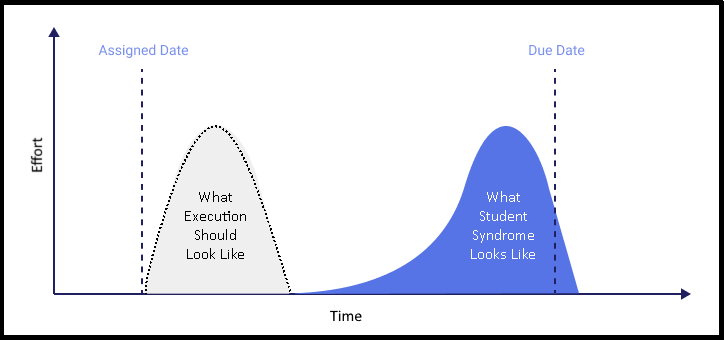Student Syndrome
Effort delayed is flow disrupted.
"Delay is the enemy of flow. The longer you wait to start, the harder it is to finish well." 1

Student Syndrome, a term borrowed from project management and psychology, describes the human tendency to delay starting a task until the last possible moment before a deadline. In Agile environments, where timeboxes and flow are critical, this behavior undermines predictability, quality, and sustainable pace. Though popularized in studies of academic procrastination, Student Syndrome shows up in Agile teams through last-minute task starts, rushed testing, and delayed collaborations, often masked by the appearance of being "busy" without delivering value incrementally.
Impact on Agile Teams
Student Syndrome can erode Agile effectiveness in several ways:
- Compromised Flow:
- Work piles up near the end of sprints or iterations.
- Testing, integration, and feedback get compressed, increasing error rates.
- False Predictability:
- Velocity appears stable until quality or delivery consistency collapse.
- Story progress stays in "In Progress" status too long, hiding blockers.
- Reduced Collaboration:
- Late starts shorten the window for shared problem solving.
- Team members work in isolation, preventing swarming or pair programming.
- Lowered Morale:
- Repeated crunch periods create stress and frustration.
- Retrospectives reveal recurring issues without resolution.
Scenario
Consider a Scrum team with a two-week sprint. Developers plan their work with good intentions, but many stories stay untouched until day 7. Reasons vary: competing priorities, task switching, or lack of urgency. When most of the work begins in week two, testing is rushed, bugs slip through, and the team spends Sprint Review defending why work wasn't completed. Despite attending stand-ups and filling boards, true progress only happens when pressure peaks.
This becomes a cycle:
- Early in the Sprint: low urgency, shallow progress.
- Late in the Sprint: intense effort, rising defects.
- Retrospective: known issue, vague solutions.
- Repeat.
Ways to Mitigate:
Agile teams and leaders can address Student Syndrome through intentional practice design:
- Improve Task Granularity:
- Break stories into smaller slices that can be finished in 1-2 days.
- Make the Definition of Done enforce flow and test coverage early.
- Visualize and Limit WIP:
- Use Kanban-style boards to surface inactivity.
- Set Work-in-Progress limits to nudge task completion over task starting.
- Design for Early Feedback:
- Prioritize testability and review by day 3 of the sprint.
- Use fast feedback tools (e.g., feature flags, API mocks, early demos).
- Timebox Discovery and Execution:
- Apply fixed time windows to research or spike tasks.
- Use pair rotations or mob sessions to create shared ownership early.
- Reinforce Cadence:
- Rather than rely on deadlines to trigger urgency, help the team internalize a steady rhythm of progress and delivery.
- Set a consistent expectation to have work in a done or demo-ready state by mid-Sprint, not just Sprint end.
- Use Sprint Goals and Daily Scrums to anchor intent and pace, emphasizing early completion over parallel starts.
- Promote early refinement and just-in-time planning so work is ready before it's urgent.
- Rather than rely on deadlines to trigger urgency, help the team internalize a steady rhythm of progress and delivery.
Conclusion:
Student Syndrome challenges Agile teams not through bad intent but through a flawed response to unstructured time. Agile frameworks give structure, but human behavior fills in the gaps. Without proactive design, teams fall into cycles of delay, stress, and rework. Agile coaches must surface this behavior not as blame, but as a system to refactor. When teams start work early, finish incrementally, and make progress visible, they escape the trap of last-minute sprints and reclaim sustainable delivery.
Key Takeaways
- Student Syndrome causes people to delay meaningful work until urgency peaks.
- In Agile, it disrupts flow, delays feedback, and weakens quality.
- Breaking work into smaller chunks and enforcing early testing help counteract it.
- Visual tools like Kanban boards and WIP limits make delay patterns visible.
- Timeboxing and recurring early-sprint practices can shift behavior upstream.
Summary
Student Syndrome quietly undermines Agile delivery by encouraging late starts and compressed execution. Though deadlines exist in Agile, the system thrives on early collaboration, testable increments, and steady progress. When teams rely on pressure to trigger productivity, they sacrifice quality and sustainability. The remedy lies in structure, visibility, and habits that reward early momentum over last-minute heroics.